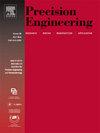Research on the gear bending fatigue full-life prediction model of considering hobbing residual stress
IF 3.5
2区 工程技术
Q2 ENGINEERING, MANUFACTURING
Precision Engineering-Journal of the International Societies for Precision Engineering and Nanotechnology
Pub Date : 2025-05-23
DOI:10.1016/j.precisioneng.2025.05.020
引用次数: 0
Abstract
This study introduces a co-simulation model incorporating the effects of hobbing axial and radial residual stresses (RS). Utilizing Smith-Watson-Topper critical plane fatigue criteria, this study establishes an SWT fatigue life prediction model accounts for axial and radial RS corrections, enabling prediction of crack initiation life (CIL) and crack initiation orientation (CIO). Utilizing maximum circumferential stress criterion and Paris law, this study establishes a tooth root 3D crack propagation model of considering RS, enabling prediction of crack propagation life (CPL) and crack propagation path (CPP). Single tooth bending fatigue (STBF) experiments were performed to assess the predictive accuracy of the model. The findings suggest that radial RS has a greater effect on the full-life compared to axial RS. CPL constitutes roughly 20 % of the full-life. The conclusion demonstrates that the CIL prediction model achieves high accuracy when the axial RS influence coefficient is 0.019 and the radial RS influence coefficient is 0.974. The 3D crack propagation model predicts the CPL and CPP that are well aligned with the actual CPL and CPP. Additionally, the predicted gear bending fatigue full-life (CIL and CPL) lies within the 1.5 scatter factor bond, indicating reliable predictive accuracy of the model across different RS scenarios.
考虑滚齿残余应力的齿轮弯曲疲劳全寿命预测模型研究
本文介绍了一种结合滚齿轴向残余应力和径向残余应力影响的联合仿真模型。利用Smith-Watson-Topper临界平面疲劳准则,建立了考虑轴向和径向RS修正的SWT疲劳寿命预测模型,实现了裂纹起裂寿命(CIL)和裂纹起裂方向(CIO)的预测。利用最大周向应力准则和Paris定律,建立了考虑RS的牙根三维裂纹扩展模型,实现了裂纹扩展寿命(CPL)和裂纹扩展路径(CPP)的预测。通过单齿弯曲疲劳(STBF)试验对模型的预测精度进行了验证。研究结果表明,与轴向RS相比,径向RS对全寿命的影响更大,CPL约占全寿命的20%。结果表明,当轴向RS影响系数为0.019,径向RS影响系数为0.974时,CIL预测模型具有较高的精度。三维裂纹扩展模型预测的CPL和CPP与实际CPL和CPP很好地吻合。此外,预测的齿轮弯曲疲劳全寿命(CIL和CPL)在1.5散点因子键内,表明该模型在不同RS情景下的预测精度可靠。
本文章由计算机程序翻译,如有差异,请以英文原文为准。
求助全文
约1分钟内获得全文
求助全文
来源期刊
CiteScore
7.40
自引率
5.60%
发文量
177
审稿时长
46 days
期刊介绍:
Precision Engineering - Journal of the International Societies for Precision Engineering and Nanotechnology is devoted to the multidisciplinary study and practice of high accuracy engineering, metrology, and manufacturing. The journal takes an integrated approach to all subjects related to research, design, manufacture, performance validation, and application of high precision machines, instruments, and components, including fundamental and applied research and development in manufacturing processes, fabrication technology, and advanced measurement science. The scope includes precision-engineered systems and supporting metrology over the full range of length scales, from atom-based nanotechnology and advanced lithographic technology to large-scale systems, including optical and radio telescopes and macrometrology.

 求助内容:
求助内容: 应助结果提醒方式:
应助结果提醒方式:


